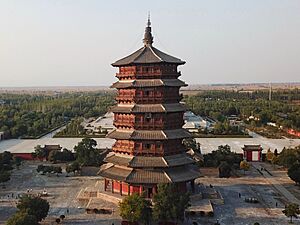Pagoda of Fogong Temple facts for kids
Quick facts for kids Pagoda of Fogong Temple |
|
|---|---|

Front view of the Sakyamuni Pagoda of Fogong Temple
|
|
| Religion | |
| Affiliation | Buddhism |
| Location | |
| Location | Ying County, Shuozhou, Shanxi, China |
| Country | PRC |
| Architecture | |
| Architectural type | Chinese |
| Completed | 1056-1195 |
The Sakyamuni Pagoda of Fogong Temple (simplified Chinese: 佛宫寺释迦塔; traditional Chinese: 佛宮寺釋迦塔; pinyin: Fógōng Sì Shìjiā Tǎ) is an amazing wooden tower in Ying County, Shanxi province, China. It is also known as the Wooden Pagoda of Ying County. This incredible building was first built in 1056 during the Liao dynasty. It was later updated and made bigger in 1195 during the Jin Dynasty.
The pagoda was built by Emperor Daozong of Liao at the place where his grandmother's family lived. This wooden tower has survived many big earthquakes over hundreds of years. It became so famous in China that people simply called it the "Muta" (which means Timber Pagoda).
The pagoda stands on a stone platform that is about 4 meters (13 feet) tall. It has a steeple (the pointy top part) that is 10 meters (33 feet) tall. In total, the pagoda reaches a height of 67.31 meters (220.83 feet). It is the oldest wooden pagoda still standing in China today.
Contents
History of the Wooden Pagoda
The Pagoda of Fogong Temple was built about 85 kilometers (53 miles) south of the Liao dynasty's capital city, Datong. Some old books say that a different pagoda was there before, built between 936 and 943. However, other records and scientific tests show that the current pagoda was built in 1056.
For example, a book from the Ming dynasty says that a Buddhist monk named Tian paid for and built the pagoda in 1056. Modern tests on the wood from the pagoda also show that it is about 930 to 980 years old. This matches the 1056 date.
The pagoda's construction in 1056 might be linked to Emperor Daozong of Liao. He was a very religious Buddhist. He was also raised in Ying County, where the pagoda stands. The pagoda, like a stupa, represents the death of the Gautama Buddha. Emperor Daozong might have connected this to his own father, Emperor Xingzong, who had passed away.
The pagoda was built in the middle of the temple grounds. The temple was first called Baogong Temple, but its name changed to Fogong in 1315. The temple grounds were once very large, but they became smaller over time.
Records show that the pagoda survived seven earthquakes between 1056 and 1103. It only needed ten small repairs in its long history before the 20th century. However, it needed major repairs after Japanese soldiers shot it more than 200 times during the Second Sino-Japanese War.
During repairs in 1974, workers found many important items. They discovered old Buddhist texts from the Liao dynasty. These included 12 scrolls printed with movable type, which was a new technology at the time. They also found 35 scrolls printed with wooden blocks and 8 handwritten scrolls. In 1974, a special Buddha tooth relic was also found hidden inside one of the Buddha statues on the fourth floor.
Unique Features of the Pagoda
The pagoda uses 54 different kinds of special wooden supports called bracket arms. This is the most found in any building from the Liao dynasty. Between each outer story of the pagoda, there is a hidden middle floor. These hidden floors are where the bracket arms are located on the outside.
From the outside, the pagoda looks like it has only five stories. It also has two sets of roof eaves on the first story. But inside, the pagoda actually has nine stories in total! The four hidden stories can be seen from the outside by the pagoda's pingzuo (which are like small balconies).
A circle of columns supports the lowest roof on the ground floor. The pagoda also has strong columns inside for support. A large statue of the Buddha Sakyamuni sits in the middle of the first floor. Above its head is a beautifully carved ceiling called a zaojing (caisson). Every story of the pagoda has a zaojing carved into its ceiling.
The windows on the pagoda's eight sides offer amazing views of the countryside. You can see Mount Heng and the Songgan River. On a clear day, you can even see the pagoda from about 30 kilometers (19 miles) away!
Protecting the Pagoda
The Pagoda of Fogong Temple and the area around it are protected by the Chinese government. More than a million dollars have been spent on studying how to repair and save this ancient building. It is very old and needs careful attention.
In 2011, officials in Shanxi province said they would apply for the pagoda to be added to the UNESCO list of protected world heritage sites. This would help make sure the pagoda is preserved for many more years.
The Pagoda Today
In 2013, the Pagoda of Fogong Temple was placed on China's list of sites being considered for UNESCO World Heritage Site status. It was listed along with the Fengguo Temple.
See also
- Architecture of the Song dynasty
- List of tallest structures built before the 20th century
Images for kids





